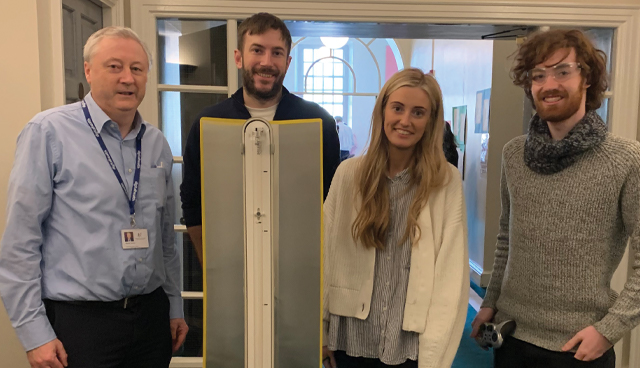Digital health transformation: Laggard to leader?

In the race to secure the digital transformation of Europe’s health services, Ireland currently lags behinds many countries. Ciarán Galway discusses the HSE’s digital ambitions and the catalytic effect of Covid-19 with its Director of Digital Transformation and Open Innovation, Professor Martin Curley.
Amid spiralling health budgets, countries across Europe are shifting towards people-centred, efficient, and sustainable health systems. Harnessing the opportunities presented by existing digital technologies and data is key to this transformation. While this ‘fourth industrial revolution’ has transformed societies more broadly, health lags behind other sectors. The OECD maintains that technology is no longer the obstacle. Rather, regulation, alongside the governance of health systems, is now the major obstacle. “A genuine digital transformation is a political choice,” it asserts.
Indeed, while digital transformation is underway across the HSE, the OECD health policy study ‘Health in the 21st Century’ indicates that Ireland is still lagging behind other European health services. The HSE Digital Transformation and Open Innovation team was established in mid-2019 with a stated vision of “developing and unleashing the digital capability of the HSE and associated ecosystem to drive breakthrough improvements in health service efficiency, effectiveness and experience”.
Digital transformation and the use of digital technology is crucial to the achievement of the Sláintecare objectives. HSE Digital Transformation is a divisional unit within the Office of the CIO (OoCIO) and has evolved to focus on technological solutions, testing and adoption.
“Historic underinvestment in digital healthcare is one of the primary reasons that we are lagging. It wasn’t prioritised as an initiative that should be invested in. The Covid-19 pandemic has shown the value of being able to use digital technology and we anticipate this will make investment in digital healthcare a new imperative for the HSE,” explains the HSE Digital Transformation team Director, Martin Curley.
Strategy
In collaboration with leaders across the HSE, Curley is tasked with four objectives:
1 Accelerating the adoption of digital technologies and solutions to transform Irish healthcare.
2 Supporting and influencing digitally driven change across the organisation to support the successful implementation of Sláintecare.
3 Building a consistent vocabulary, language and tone for digital across the HSE.
4 Delivering a digital learning programme to a wide range of staff in the HSE and across the wider health sector.
Similarly, the HSE’s digital transformation strategy has five pillars.
1. Digital Academy:
As is the case in the UK, Ireland has established a Digital Academy to educate and create digital leaders as well as digital practitioners. More comprehensive than the UK model, a new master’s in digital health transformation has been launched with 50 students having already embarked on that journey.
2. Open Innovation:
The HSE Digital Innovation team alone cannot bring digital transformation to the wider organisation. Instead, it is orchestrating the digital health ecosystem around the ‘stay left, shift left’ strategy. ‘Stay left’ is about using technologies to keep people well and ‘shift left’ is about using technologies to move people from acute settings to community or home settings as soon as possible.
3. Digital Labs
Digital labs enable the deployment of a technology in real world scenarios, rapid iteration and the production of workable solutions as well as business cases that then enable broader adoption of that technology.
4. Digital Academy Forum
Hosted quarterly, the Digital Academy Forum is a platform for ideas and views on digital health agenda, digital transformation and innovations across the Health Service to be shared and discussed by medical staff, academics, industry leaders, and patients and citizens. Ultimately, the forums inform Ireland’s National Digital Healthcare Strategy, in line with the government’s 10-year Sláintecare strategy.
5. Digitisation
This is the actual act of moving the organisation from analogue to digital. Robotic process automation (RPA) is one of a number of key tactics being deployed to support this.
According to Curley, the establishment of the HSE Digital Innovation team was a recognition of the need for an organisation to help galvanise and drive digital transformation. “We are chartered with pathfinding the future and running proof of concepts,” he says, adding: “We want to improve capability, competence, capacity and confidence. If we are successful, in five years’ time Ireland will have moved from European digital laggard to European digital leader and we would have improved the efficiency, effectiveness and experience of the wider healthcare system.”
Holistic change
A key tenet of this mission is contained within a quote from Nobel laureate Ilya Prigogine who said: “In an unstable complex system, small islands of coherence have the potential to change the whole system.” The HSE Digital Transformation team is a small group, driving a coherent digital message in the hope of effecting impact on the broader health system.
“If we are successful, in five years’ time Ireland will have moved from European digital laggard to European digital leader and we would have improved the efficiency, effectiveness and experience of the wider healthcare system.”
For Curley, bridging gaps is also an important element of his mission. “When we apply the idea of open innovation 2.0, it is about the concept of quadruple helix innovation whereby we support the alignment of government, industry, academia and citizens around a common vision.
“Innovation can very often be described as developing new combinations of existing and emerging technologies to solve problems. Often, we are trying to synthesise various insights, new technologies and solutions to do things in a new way or to do things that would have been otherwise impossible,” he outlines.
HSE Digital Transformation has a digital innovation portfolio of around 50 technologies that it tracks and recently opened a portal for organisations to submit ideas, receiving around 100 submissions. This has yielded between 12 and 14 real life projects, some of which are already adopted while others are in the process of proof of concept and hopefully adoption.
Process
Curley and his team work to generate a business case from a proof of concept, for the broader adoption of these specific solutions. Simultaneously, it works on the cogeneration of documentation, such as a data protection impact assessment, so that when a solution is adopted, it is ready for deployment.
For digital technologies and solutions, there is typically a four-stage process for broad adoption across the health system. “Firstly, we have the idea and review whether or not it is good. Then we establish a proof of concept which is a small-scale test of the technology. If and when the proof of concept indicates that the idea is worth exploring further, we attempt a demonstrator which uses the technology in a real-life environment. The output of this is a business case for broad adoption across the wider organisation,” Curley discloses.
In the context of Covid-19, some solutions have progressed through this process very quickly. “Arguably, we have had two to three years of progress within two to three months,” the HSE Digital Transformation Director suggests, adding: “In the past, this process would have taken several years. We are attempting to reduce it to a calendar year. That would be aggressive but it’s something that we think is achievable.”
‘Stay left, shift left’
Meanwhile, the ‘Stay left, shift left’ strategy is at the forefront of developing a business case for broad adoption. Curley uses the proof of concept being started with DermView, a company specialising rapid teledermatology diagnosis service, as an example.
“Today, the waiting list for a dermatology consultant appointment extends to three years in St James’s Hospital. We want to use DermView’s technology to identify anyone who has been on the waiting list for over 15 months and photograph the area of skin that is causing them a problem for offline review by consultants.
“Some very early pre proof-of-concept work in St James’s Hospital has indicated that at least 50 per cent of cases didn’t require a consultant. In this case, the benefit would be a dramatic shortening of waiting lists as well as earlier detection of potentially harmful skin aberrations. We try to capture cost savings like this in a business case,” he indicates.
Curley wants to create a standard set of value dials. These are indicators that can be improved. As each technology comes under our consideration, its potential efficiency improvement, the effectiveness improvement and the experience improvement can be analysed. This saving can then be quantified with a figure. For instance, the equivalent of one bed night saved is between €850 and €1,000, depending on the hospital.

Covid-19 priorities
A key component of the HSE’s response to the pandemic has been collaboration with external companies to take digital solutions, rapidly verify and pilot the concept and then drive adoption as soon as possible.
For example, the health service has worked with patientMpower to develop a solution that remotely monitors Covid-19 patients using a mobile app and a Bluetooth-enabled pulse oximeter. To date, more than 1,000 patients across 20 hospitals have been monitored from home using this technology. If an individual’s oxygen saturation level drops below 94 per cent then an alert is generated. With the patient’s clinician involved, a decision is made as to whether the patient requires a hospital admission or not.
patientMpower has swiftly pivoted to repurpose its technology for monitoring lung transplant patients and patients with cystic fibrosis. Praising this response from industry, Curley references several other examples of solutions being configured alongside external partners.
“We have worked with RedZinc, a software-as-a-service company which specialises in a simple and secure videoconferencing tool whereby a consultant or doctor sends a text link to a patient who can then press that to open a secure two-way communication. St James’s Hospital’s and three-hundred mental health consultants are using this technology today. Again, this is a reapplication of an existing technology, but we started to deploy it within two weeks of our first interaction with RedZinc.
“We also worked with Wellola and Nua Health to repurpose some of their sites to create video consultation platform for GPs and health centres. In the space of 48 hours, Wellola and Nua Health both signed up over 600 organisations and GPs to use their software,” he says.
Some of the work being undertaken is more experimental. For instance, Midland Regional Hospital Tullamore have been trialling an ultraviolet cleaning robot called Violet. “The initial results of this are very promising. We would like to run a more thorough pilot in Tullamore, quickly, to get evidence to drive broad adoption. The data is quite compelling that it is an effective Covid-19 killer.”
“Likewise, we collaborated with S3 Connected Health which has developed a solution called ACORRD, for triage and patient management of Covid-19 patients within pre-ICU settings in hospitals. We were anticipating the potential for hospitals to be overrun similar to what happened in Italy. Therefore, this was a tool developed to determine which patients really required ICU and what interventions are necessary for the other patients,” Curley clarifies.
Other solutions adopted are relatively simple and include a non-contact digital thermometer (thousands of units of which are being distributed to nursing homes and hospitals) developed by Belfast-based TriMedika, and a thermal kiosk for nursing homes in which a staff member or visitor entering the facility can position their face in front of screen which displays their temperature.
Secondary legislation
Another important change that has happened during the Covid-19 crisis is the introduction of secondary legislation to facilitate the safe supply of medicines. The Medicinal Products (Prescription and Control of Supply) (Amendment) Regulations 2020 allows for the electronic transfer of prescriptions between GPs and pharmacies and remove the need for a paper equivalent.
“That wasn’t really a technological innovation because that technology existed, it just wasn’t legal to do so. Covid-19 precipitated that and today, there are over 1,000 pharmacies receiving electronic prescriptions and there are approximately 1,500 GPs transferring prescriptions electronically. That was an important breakthrough. The technology was very simple, but it needed legislative change to get that in place.”
Overall, while conceding that cultural change is a challenge, Curley has been encouraged by a general willingness to adopt digital technologies such as teleconferencing and the remote management of patients as a matter of necessity.
Praising the collaboration within the entire digital health ecosystem, he concludes: “We have many people within the ecosystem who are willing to help. Working with our colleagues throughout the HSE, I think we can get breakthroughs which will allow us to become a European digital leader within a five to seven-year timeframe.”





